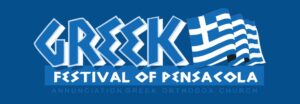One of the highlights of the Pensacola Greek Festival each year is watching the dancers and then joining them on the dance floor. Two groups of youth dancers perform – the younger group is called Hara which means Joy in Greek. The middle and high school group is called the Glenzethes which means “Merry Makers”. They perform three sets on Friday and Sunday and five on Saturday. Specific times are listed on the festival schedule page.
The youth of the Annunciation Parish have been performing folk dances for many years. Initially Greek dance lessons were incorporated into the Greek language and culture classes taught to the children by a long-time member of the parish, Mrs. Mitsa Morres, starting in 1964. The formal youth dance program was started in 1984 when the state of Florida provided a grant to promote cultural arts in the state. The first dance group had 16 high school students – some who are now parents and teachers of our current dancers.
The dancers practice weekly for three months to prepare for their festival performances. In addition to attending practices and learning the dances, each dancer has stewardship requirements that include attending church services and Sunday School and participating in the youth program and associated service projects.
Each of the girls in the Glenzethes group has two costumes. One is a unique handmade costume that is representative of the region of the Greece that her family is from. The other is a blue velvet costume trimmed in gold that is worn by all the girls and comes from the Cyclades Islands.
Daphne Pagonis, the dance instructor for the Glenzethes, is an alumni of the youth dance program.
The dancers learn 20 different dances and perform four or five dances per set during the festival with the girls alternating costumes between sets. Audience members participate by clapping hands and throwing money at the dancers. The old tradition of breaking dishes on the floor at Greek parties is no longer practiced but audience members often shout “Opa!” and throw money on the floor to show their appreciation and pride of the dancers.
After the dance troupe completes their set, audience members usually rush out to the dance floor to join in the fun. Beginners and experts can dance together, as the basic steps are fairly easy to learn.
Learn about the Greek Folk Dances
The most common dances enjoyed at a typical Greek festival in America will be the Syrto, Kalamatiano, Tsamiko and Zembekiko. Most dances are circle dances, starting with the right foot and moving counter-clockwise. Each dancer is linked by a handkerchief or by holding hands, wrists or shoulders. The common “Circle” dance is part of a great Greek tradition that dates back to the Byzantine period. Read full article
Learn Greek Dancing
Everyone is invited on the dance floor. If this is your first festival or your first time on the dance floor, don’t be nervous. Just get out there and grab the hand of the person next to you in line and follow their footsteps. To help newcomers learn the basic steps, the Pensacola Greek Festival is providing dance lessons on Saturday. These are all line dances that do not require partners or previous experience. Read full article.
